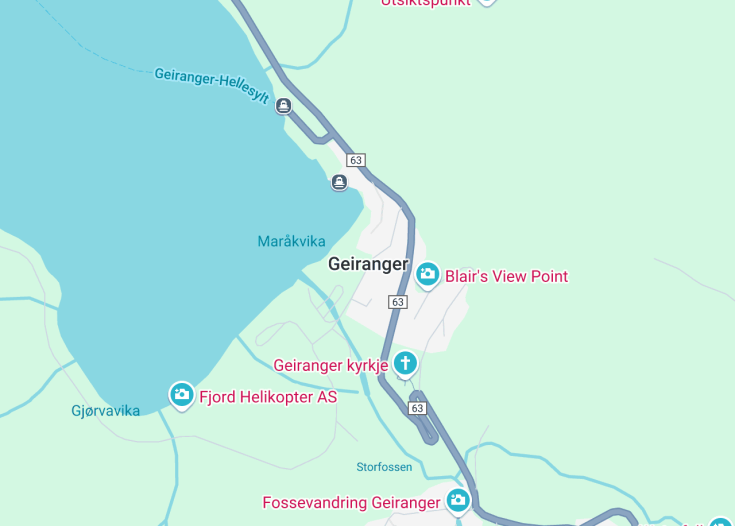Nestled in the heart of Norway’s fjord country, Geiranger boasts dramatic landscapes that captivate and enchant visitors from around the world. This UNESCO World Heritage site features the iconic Geirangerfjord, known for its deep blue waters and stunning waterfalls including the famous Seven Sisters and Bridal Veil.
Surrounded by steep cliffs and lush greenery, Geiranger offers a myriad of outdoor activities such as hiking, kayaking, and fishing. Its scenic beauty and tranquil environment make it an ideal destination for nature lovers and adventure seekers alike.
For an unforgettable experience, take a fjord cruise to fully appreciate the majestic beauty and serene atmosphere of Geirangerfjord.
Consider visiting Geiranger during the early summer to enjoy mild weather and fully bloomed landscapes, enhancing your sightseeing and outdoor activities.
Top things to do & see in Geiranger
Select the following sights and activities to discover best tickets and tours available in Geiranger.
Geiranger: A Natural Paradise
| Country | Norway |
| Time in Geiranger | GMT+2 |
| Language spoken | Norwegian |
| Population | 250 (source: Norway’s National Statistics Bureau) |
| Currency | Norwegian Krone (NOK, kr) |
| Airports |
|
Located in the heart of Norway, Geiranger is nestled in a deep valley surrounded by towering cliffs and stunning fjord views. This UNESCO World Heritage site is not just a feast for the eyes but also a haven for nature lovers and adventurers. The village itself, though small with a population of just 250 people, is full of charm and history. The Geirangerfjord, which the village overlooks, is famous for its breathtaking waterfalls including the Seven Sisters and the Suitor, visible from numerous points on the fjord’s clear waters.
Where is Geiranger?
Geiranger is situated in the Sunnmøre region of Møre og Romsdal county in western Norway, steeped in stunning natural beauty.
Distances:
| Route | Distance by car | Time by car |
|---|---|---|
| Oslo to Geiranger | 450 km | 7 hours |
| Bergen to Geiranger | 380 km | 6-7 hours |
| Trondheim to Geiranger | 330 km | 6 hours |
What is Geiranger famous for?
Geiranger is renowned for its dramatic scenery, including steep mountains, lush valleys, and the iconic Geirangerfjord, known for its deep blue waters and stunning waterfalls.
History
Early Settlements (Pre-800 AD)
The area now known as Geiranger in Norway boasts an extensive history, dating back to the pre-Viking era. Initial settlers, primarily fisherman and farmers, were drawn to the region’s fertile grounds and abundant marine resources. These early inhabitants established rudimentary societies, exploiting the rich natural bounty offered by both the fjord and the surrounding landscapes.
Viking Era (800-1066 AD)
During the Viking age, Geiranger became a notable site for Norse explorers. The fjord served as an excellent strategic point for launching voyages into the North Atlantic. Local myths and oral histories frequently reference sea rovers who dwelt in the area and tales of their exploits which contributed to the rich tapestry of regional folklore that continued to be passed down through generations.
Christianization and Growth (1066-1500 AD)
With the introduction of Christianity, Geiranger experienced significant transformation. Religious settlements emerged, and the fjord region saw the construction of churches and religious communities. This period marked a shift towards a more structured society, intertwined heavily with the religious influences from the rest of Europe.
Rise of Tourism (1800s-Present)
The 19th century introduced another key chapter in Geiranger’s history with the advent of tourism. The fjord’s breathtaking vistas attracted tourists from across Europe, transforming the local economy. Today, Geiranger is recognized globally for its stunning landscapes, being listed as a UNESCO World Heritage Site, and continues to draw visitors seeking its natural beauty and historical intrigue.
Visit Geiranger
What to see and do in Geiranger
Explore the mesmerizing beauty of Geiranger by visiting its famed fjord, recognized as one of the most picturesque natural sites globally. Take a fjord cruise to enjoy panoramic views of the waterfalls, cliffs, and verdant mountainsides.
Adventurous souls can engage in kayaking or hiking trails like the one leading to Flydalsjuvet, offering a spectacular view of the fjord. The Norwegian Fjord Centre is a must-visit for those interested in understanding the cultural history of the area.
- Fjord sightseeing by cruise or kayak
- Hiking to Flydalsjuvet
- Visiting the Norwegian Fjord Centre
Festivals and Events in Geiranger
Geiranger hosts several cultural events throughout the year, reflecting Norway’s rich traditions. The Geiranger From Fjord to Summit in June and the Geiranger Chocolate Festival in October are notable highlights, offering unique experiences ranging from athletic competitions to culinary indulgence.
Best time to visit Geiranger
The ideal time to visit Geiranger is between May and September when the weather is most favorable for outdoor activities and the natural scenery is at its peak. This period also coincides with the majority of local events and festivals.
Is Geiranger worth visiting?
Geiranger is undoubtedly worth a visit. Its status as a UNESCO World Heritage Site speaks volumes about its spectacular natural beauty and cultural significance.
Whether you are an outdoor enthusiast or a history buff, Geiranger offers a diverse range of activities and breathtaking sights that ensure a memorable stay.










